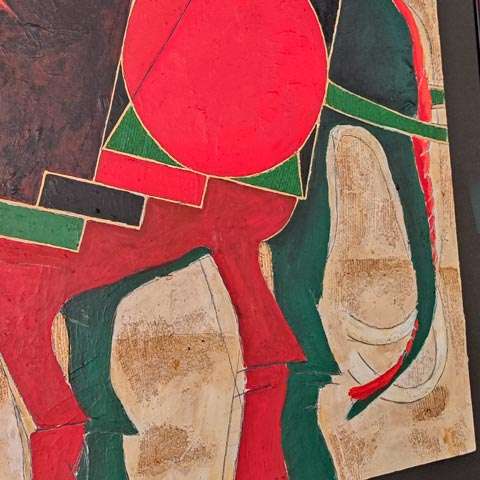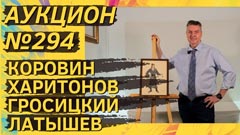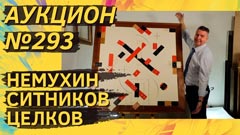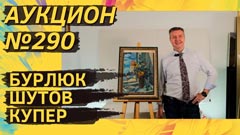
1960s UNOFFICIAL ART
NEMUKHIN Vladimir Nikolaevich (1925–2016) Super elephant. 1993. Cardboard, graphite pencil, ink, acrylic. 65×49.5
Nemukhin's original super-elephants exist in many designs. There are even exotic pink elephants. I suppose that initially the construction of Suprematist symbols should have been called “SUPRE-elephant”. But in our latitudes, the elephant became Russified and turned into “super”. This program plot without cards was much beloved by collectors. Everyone wanted one: “Vladimir Nikolaevich, make me a super-elephant too!” Not surprisingly, over time, the herd grew larger. But it was almost impossible to buy super-elephants in the open sale, at public auctions. It was, and still is, an “insiders only” exclusive. So every appearance of such a thing at auction in Russia is an event. Such a chance should not be missed.
VECHTOMOV Nikolay Evgenievich (1923–2007) Harmony. 1989. Oil on hardboard. 70.5×50.5
Vechtomov in blue, not red. Extraordinary beauty. And very rare! Collectors hunt for such works, looking for them, asking for them. But in the open sale, such things do not appear not only every month, but not every year! And here's that chance. Classic Vechtomov with his alien biomorphic structures. 1989.
Nikolai Vechtomov is a veteran, a member of the Lianozovo group, an associate of Rabin and Nemukhin. His palette and system of images were formed under the impression of explosions of bombs and shells. Vechtomov was the participant of historical exhibitions in the club “Friendship” (1967), in the pavilion “Beekeeping” at VDNKh (1975). Today Nikolay Vechtomov is one of the most popular and liquid artists of the post-war unofficial art.
BELENOK Petr Ivanovich (1938–1991) Attack. 1977. Hardboard, oil, collage, author's technique. 99×71
A meter-sized Belenok, published, with good provenance and expert opinion by Valery Silaev. A particularly valuable period piece. A classic of Panic Realism. Ready collectible and investment option.
Belenok was one of the main innovators of post-war unofficial art. He consistently developed the theme of the conflict between man and the environment. The conflict is acute, on the point of rupture, with unpredictable consequences. His style has been called “catastrophism”. But this does not mean that any subject is doomed to disaster in the finale. “Attack” is just such an example of an optimistic picture. Danger is met with a smile on the face. The work is painted during the period of the first confession. Behind is the “Beekeeping” pavilion at the VDNKh and a succession of exhibitions abroad. The artist died in the midst of the wild nineties, in need, almost in poverty. Today Belenok is one of the most popular artists of his generation. In two years the prices of his paintings have increased by 2–2.5 times.
ORLOV Boris Konstantinovich (1941) Musician (red). 1978. Porcelain, overglaze painting. 45.5×37
Boris Orlov calls himself an “imperial artist” and even a “political artist”. An artist of the 1970s, a representative of the younger generation of unofficial Soviet art, he developed a distinctive style of social heraldry. His characters, like our trumpeter, are often devoid of faces. Their identity is defined by insignia, pseudo-orders, chevrons, stripes, and ribbon bars. People are not people, but manifestations of social roles. This is evident in our musician. A playing uniform. A function bloated with importance.
Orlov's musicians exist in blue and red uniforms (you can see them in the catalog “Porcelain of the Sixties”). Inside, next to the signature, the date is 1978. Although the porcelain was made in the 2010s. This is not a mistake, but the position of the author. He puts the date of conception, the year the concept was invented, cast in bronze. The sculpture comes from the author's edition, which had 4 copies. Hence the number — IV/2.
RABIN Oscar Yakovlevich (1928–2018) Eiffel Tower with bananas. 1979–2008. Porcelain, hand-painted overglaze. 31.5×36
Oskar Rabin was a key figure of non-conformism, the leader of the Lianozovo group, the organizer of the Bulldozer exhibition, and an uncompromising fighter for freedom of creative expression. After a series of provocations, he was forced to leave the USSR and was deprived of Soviet citizenship in 1978 on the grounds that “his activities dishonored the title of a Soviet citizen”.
In France, Rabin's style changed. The “barrack” aesthetic was replaced by a more romantic Parisian one. Rabin did not stop being a hooligan, but became more decorative and understandable to the European public. Even now it is obvious to any viewer that he is facing the symbol of France. And why bananas — it is another question. The porcelain is based on a drawing of 1979, the first year of emigration. The dish was issued in a small edition of 25 copies. It is interesting that the previous owner did not dust it off, but used it as intended — the dish was hanging on the wall as a piece of furniture. And so it should.
CONTEMPORARY ART
MARKOVNIKOV Boris Vladimirovich (1958) Invasion. 1996. Oil on canvas, mixed media. 70 × 70
Boris Markovnikov is an “artist of experience”, an original, very recognizable modern abstractionist. His deep textural painting (grattage) often takes an intermediate place between the picture plane and the volume of relief. Connoisseurs of abstraction have long paid attention to him. Markovnikov was nominated for the Kandinsky Prize in 2008. His works are in the Tretyakov Gallery and the Russian Museum, represented in the collections of Viktor Bondarenko, Mikhail Alshibai, German Titov, Konstantin Ernst.
- Log in to post comments










